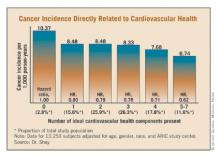Meeting a greater number of the American Heart Association’s seven ideal cardiovascular health components is a twofer: not only is it associated with a reduced incidence of cardiovascular disease, but with a lower incidence of several major types of cancer as well.
By the same token, a separate study, this one in the cancer literature, has recently documented that individuals who adhere more faithfully to the American Cancer Society’s recommended lifestyle behaviors have sharply reduced mortality from cardiovascular disease as well as a lower risk of death due to cancer during long-term followup.
The two groups’ health promotion recommendations share many similarities. Both emphasize the importance of normal body weight, physical activity, and a healthy diet.
The new data documenting crossover benefits from the health promotion guidelines put forth by two major organizations focused on separate diseases are expected to bring renewed energy to collaborative AHA/ACS public health efforts.
"These findings can be used to simplify public health messages by emphasizing a core set of risk factors for prevention of multiple chronic diseases," said Christina M. Shay, Ph.D., of the University of Oklahoma in Oklahoma City.
Such a stripped-down core message ought to help quell public frustration with often-conflicting health advice and contradictory medical recommendations, she added.
In 2004 the AHA, ACS, and American Diabetes Association formed the Preventive Health Partnership, an ongoing joint effort to reduce the burden of cardiovascular disease, stroke, cancer, and diabetes. The partnership has led to public health campaigns, public service announcements, and advocacy efforts.
Dr. Shay and coworkers recently examined the anticancer impact of adherence to the AHA’s seven ideal cardiovascular health components using the Atherosclerosis In Communities (ARIC) study cohort. ARIC is a prospective, multicenter, population-based study involving roughly 16,000 middle-aged white and African American men and women who have been reexamined at 3-year intervals. ARIC is rare among cardiovascular studies in that it has prospectively collected reliable data on cancer incidence.
The AHA’s seven ideal cardiovascular health components are a body mass index less than 25 kg/m2, nonsmoking for at least the last 12 months, an untreated total cholesterol below 200 mg/dL, untreated blood pressure below 120/80 mm Hg, untreated fasting blood glucose of less than 100 mg/dL, at least 150 minutes per week of moderate or 75 minutes of vigorous physical activity, and a healthy diet score.
The healthy diet score requires meeting four out of the following five criteria: consumption of at least 4.5 cups of fruits and vegetables daily, eating two or more servings of fish per week, sodium intake of less than 1,500 mg per day, not more than 36 ounces of sugar-sweetened beverages per week, and at least three servings of whole grains daily.
This ARIC analysis involved 13,253 subjects with a mean baseline age of 54.1 years. The incidence of four major cancers – breast, prostate, lung, and colon – was monitored for 1978-2006. The risk of incident cancer dropped in stepwise fashion as a greater number of the ideal cardiovascular health components were met, such that individuals with five to seven of the components had an adjusted risk that was 38% less than that of individuals with none of the ideal health components.
The inverse relationship between the number of ideal cardiovascular health components met and cancer risk was strongest for lung cancer. It was also significant for prostate and colon cancer, but not breast cancer.
Dr. Donald M. Lloyd-Jones calls the new findings "incredibly important."
"What I think is really exciting and striking is the whole concept of trying to get everybody to just take one step forward. But that first step looks to be really key. Going from zero to one cardiovascular health component brings the biggest drop in risk, and that’s true both for cardiovascular disease and cancer. Maybe it’s because in just doing that one thing you actually pull a lot of other components from poor up to intermediate in a way that can’t be detected by this type of analysis," observed Dr. Lloyd-Jones, chair of the department of preventive medicine at Northwestern University, Chicago.
The seven ideal cardiovascular health components were developed in conjunction with an AHA campaign to improve the cardiovascular health of Americans by 20% by the year 2020.
In another recent ARIC analysis, a separate group of investigators showed the 20-year incidence of cardiovascular disease was only one-tenth as high in subjects with six of the ideal cardiovascular health components as it was in those with none. As was the case in the cancer study by Dr. Shay and colleagues, the incidence of cardiovascular disease also decreased in stepwise fashion with an increasing number of cardiovascular health components being met (J. Am. Coll. Cardiol. 2011;57:1690-6).



